Hi, i am a complete novice but I recently purchased a katana blade from a local market and am desperately trying to establish the swordsmith and date. As i said i only have the blade, no fixtures and fittings, though i believe it to be a Kai-Gunto Naval sword. I have attached some photo's here of the Tang, if you can make out the signature and date i would be very grateful. Thanks in advance Dominic |
|||
 |
Nihonto ClubJapanese Sword Information Exchange |
User login |
|
|
Disclaimer: Nihontō Club owners and independent contributors will not be held responsible for any loss, damage or inconvenience caused as a result of any inaccuracy or error within this website. Except where otherwise noted, this page is licensed under a Creative Commons License.
|
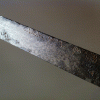
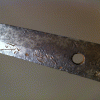
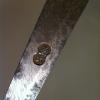
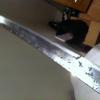
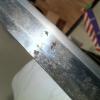

Yoshida Kaneuji
Hi Dominic,
The inscription reads:
I've merged and rotated the photos for you:
Having looked at Slough's Modern Japanese Swordsmiths: 1868-1945 [bib]sloughmjs[/bib], the signature is almost identical to Yoshida Kaneuji's. According to the inscription, the sword was made in the 17th year of Showa (1942). If you do a search in Google by the smith's name, you'll find more examples of his work.
I hope this helps.
Regards,
Stan
Seki stamp
Note that it has a "Seki stamp". This is quite common on WWII blades, but it puts a limit on the value/quality. There were usually certain shortcuts taken in the making of blades with Seki, Showa, and certain other stamps. The stamp is a type of military acceptance mark.
Pete
A Massive Thank You
Thank you both ever so much, i really appreciate your time and effort in checking this for me.
In terms of value, i am guessing this a manufactured sword and not folded, their is no pronounced Hamon on the blade but i am not sure if this is just due to the blade being in POOR condidion?
Is this likey to be a real sword or manufactured?
Do you think its worth the cost of polishing and having it restored, though i guess this depends on the question above?
I cant seem to dd additonal pictures so will put some in a new post.
Thanks
Dominic
Polishing
Hi Dominic,
I've added your new photos into the main post. You may edit it yourself and add new photos/information if needed.
Given that the signature is genuine, it is a traditionally made sword ('folded'). I presume hamon will show up after proper polishing.
Regarding the question whether to polish it or not, I can't see exactly from the photos how deep the rust is, but it doesn't look too bad. Only close examination by a specialist can tell. I don't think you'll get your money back if the sword is sold after professional polish, but if you want to restore an original war-time sword, it's worth a try. It depends on your objectives.
Regards,
Stan
also...
Here's a somewhat different view - I'm being a bit more pessimistic than Stan, but in the end you should talk to a variety of folks to get the whole picture:
A Seki-stamped "GUNTOU" is certainly a fine WWII item. But most serious collectors will not put it in the same category as a more traditionally-made blade.
The steel *may* be folded on a Seki blade, but it will almost certainly have significant shortcuts in the process. It is likely a single-piece contruction.
The HAMON is usually somewhat unclear, because the blade was quenched in oil rather than water. This was done because an oil-quenched blade is less likely to suffer cracks and other problems during the quench, which would ruin days of work in just a few moments.
The polish on a GUNTOU is almost always sub-standard. Once you compare side-by-side with a quality polish, the difference is obvious. Even if the blade is not currently in great condition, the weakness of a GUNTOU polish is easy to see.
Another hint is in the signature - the characters on many GUNTOU (like yours) tend to be "rough" and "choppy", not "beautiful" and "elegant".
A final hint is in the overall shape of the blade. It's a somewhat subtle thing that requires a bit of experience to see. A GUNTOU tends to lack an elegant shape...
I think a blade like this does not need or deserve polishing. A worthwhile polish would cost more than the blade is worth. A real TOGISHI (polisher) in Japan wouldn't do it - by Japanese standards, a GUNTOU is a "weapon", not "art". Also, you would probably not be able to get this blade into Japan at all - customs doesn't allow importing weapons. There are a couple of polishers outside of Japan that are qualified, but if they are willing to polish a GUNTOU, then I wouldn't use them... Beware of people who *claim* to be qualified to polish a Japanese blade!
But like I said, it's a fine WWII collector's item, and worth caring for as-is.
Pete
...and
I forgot to mention that the "KAKIHAN" (the large stamped marking seen in the 3rd picture) is a GOOD feature (in general) for a GUNTOU. It "probably" means that the blade is a better-quality GUNTOU - it is a fairly rare feature. Most smiths did not use KAKIHAN.
Pete
Correction
It was late in the night when I posted my last commment. I'm sorry for the lack of clarity. I meant to say that in my opinion it's only worth polishing it as a way to preserve a real war-time artifact. In the context of Nihonto, there isn't much value in having this sword polished.
Thanks again
I must say you guys really know your stuff, thanks again for all your comments and i will take your advice onboard. I won't bother with a polish in this case then, just wish i had some fittings and a saya to put it into, as i said before i only have the blade.
I am guessing all the parts of the sword are made to measure so once again i am guessing this would cost me a fortune. Though, as the blade cost me only £5 from a market i might try and make an effort!
Thanks again for all your help
Dominoic
Price
I must say it's a great price!
I bid $20!
I'll give you $20 plus shipping for it :-) .
As for fittings, yes you need to hand-pick pieces that fit. If you happen to have a Japanese sword show in your part of the world, you might find some folks with GUNTOU-type parts for sale.
Beware of cheap, modern, Chinese made stuff.
Pete